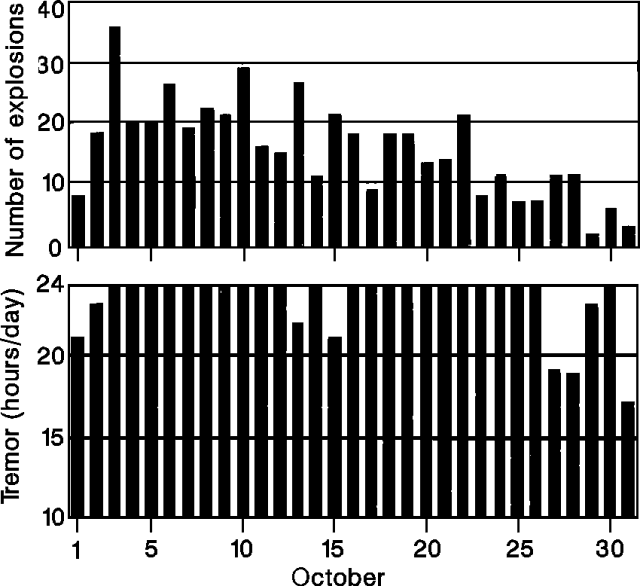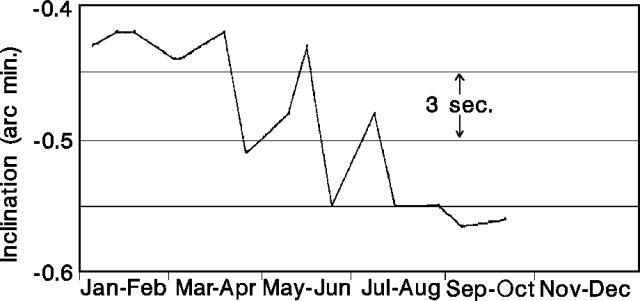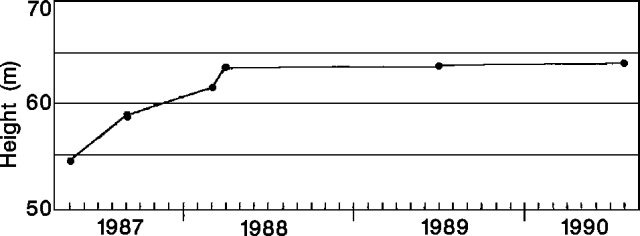Report on Arenal (Costa Rica) — October 1990
Bulletin of the Global Volcanism Network, vol. 15, no. 10 (October 1990)
Managing Editor: Lindsay McClelland.
Arenal (Costa Rica) Strombolian activity; lava flows; small nuées ardentes
Please cite this report as:
Global Volcanism Program, 1990. Report on Arenal (Costa Rica) (McClelland, L., ed.). Bulletin of the Global Volcanism Network, 15:10. Smithsonian Institution. https://doi.org/10.5479/si.GVP.BGVN199010-345033
Arenal
Costa Rica
10.463°N, 84.703°W; summit elev. 1670 m
All times are local (unless otherwise noted)
Strombolian activity and lava production continued, and occasional small nuées ardentes were observed during October. An average of 18 explosions (with three or four strong events) were recorded daily (figure 31) . . . . Explosions ejected blocks and bombs that were deposited to ~1 km from the crater, and produced ash columns 1 km high. White and occasionally bluish gas plumes were carried NW, W, and SW; acid rain continued to cause damage. At the end of October, two blocky lava flows were observed extending down the NW and SW flanks.
 |
Figure 31. Number of explosions/day (top) and hours/day of tremor (bottom) recorded at Arenal by the Univ Nacional, October 1990. |
Tremor was nearly continuous, averaging 23 hours/day (figure 31), and increased in intensity towards the end of the month as the number of explosions decreased. Deformation measurements indicated continued deflation of the volcano since 1986, with occasional pulses of inflation during explosive stages (figure 32). The area around the active summit crater (C) continued to grow by accumulation of pyroclastic materials. The rate of this accumulation, which totaled 9 m from early 1987 through May 1988, has decreased (figure 33).
 |
Figure 32. Electronic tilt measurements at Arenal, January-October 1990. Courtesy of the Univ Nacional. |
 |
Figure 33. Growth of the active crater at Arenal, April 1987-August 1990. Courtesy of the Univ Nacional. |
Geological Summary. Conical Volcán Arenal is the youngest stratovolcano in Costa Rica and one of its most active. The 1670-m-high andesitic volcano towers above the eastern shores of Lake Arenal, which has been enlarged by a hydroelectric project. Arenal lies along a volcanic chain that has migrated to the NW from the late-Pleistocene Los Perdidos lava domes through the Pleistocene-to-Holocene Chato volcano, which contains a 500-m-wide, lake-filled summit crater. The earliest known eruptions of Arenal took place about 7000 years ago, and it was active concurrently with Cerro Chato until the activity of Chato ended about 3500 years ago. Growth of Arenal has been characterized by periodic major explosive eruptions at several-hundred-year intervals and periods of lava effusion that armor the cone. An eruptive period that began with a major explosive eruption in 1968 ended in December 2010; continuous explosive activity accompanied by slow lava effusion and the occasional emission of pyroclastic flows characterized the eruption from vents at the summit and on the upper western flank.
Information Contacts: J. Barquero, V. Barboza, E. Fernández, and R. van der Laat, OVSICORI; G. Soto and R. Barquero, ICE.

